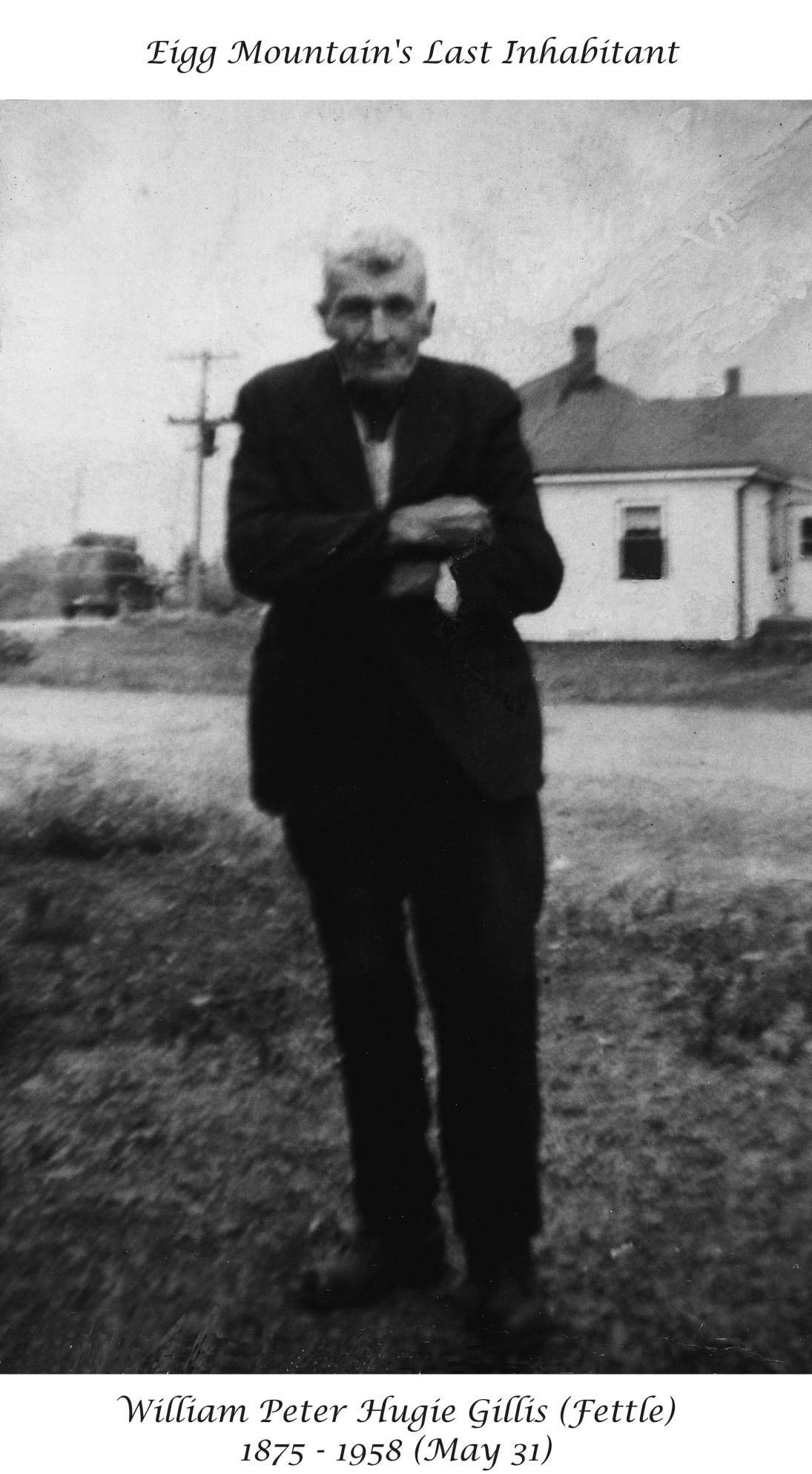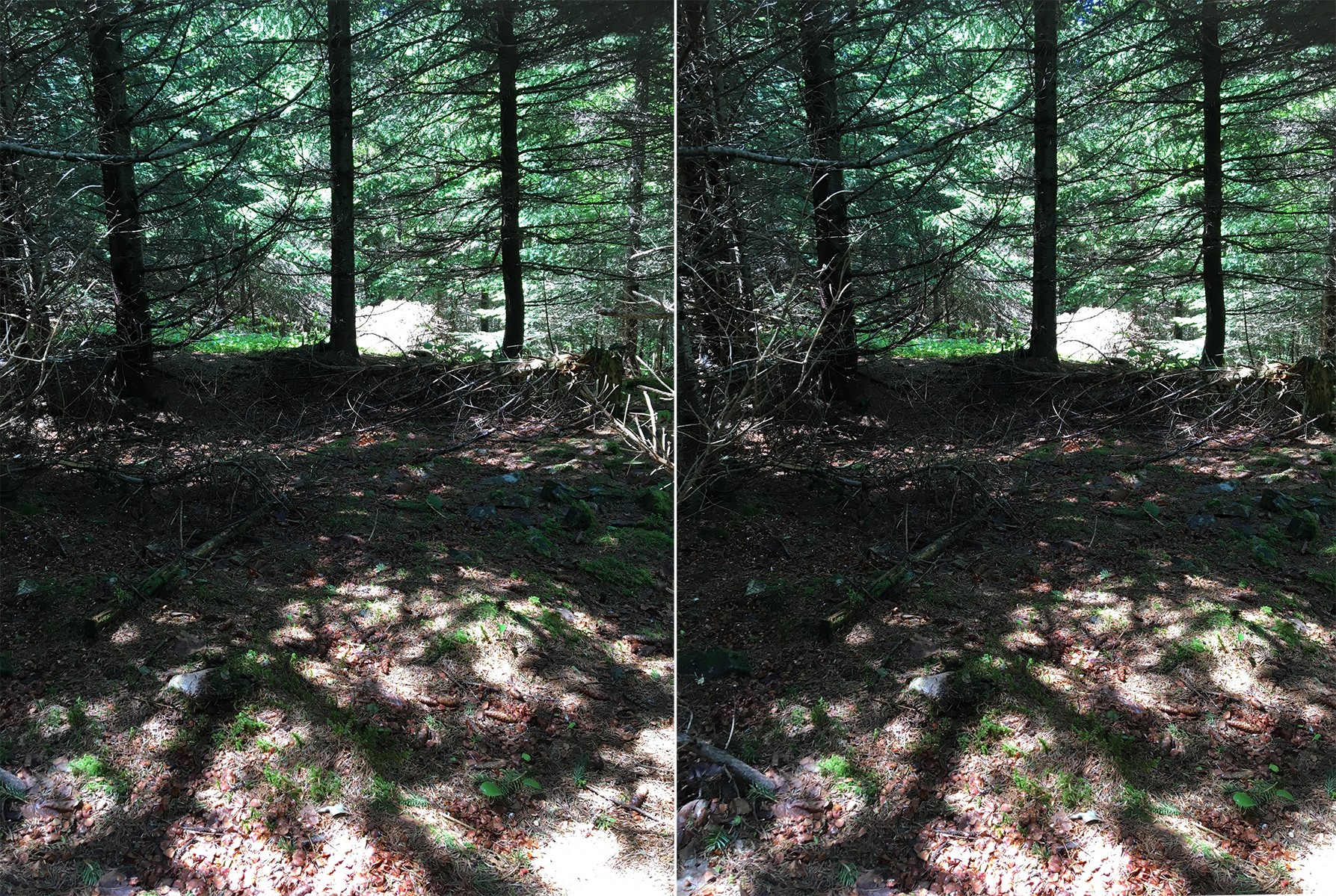Bantjes, Rod, “Gillis_Fettle.html,” in Eigg Mountain Settlement History, last modified, 24 March 2025 (http://people.stfx.ca/rbantjes/gis/txt/eigg/introduction.html).
William Peter Hughie Gillis (Fettle) (Eigg Mountain Settlement History) (Map Location)
 |
Figure 1 – Photo taken on Viewville Street. |
William “Fettle” was the grandson of the pioneer Hughie Gillis. Hughie (Ewan Mor) went to PEI from Scotland and in his late middle age he moved to Eigg Mountain. He settled here in the 1830s. Old Hughie Gillis's son Peter had taken over the farm by 1871 (when he appears in the census as head of the household), and is listed on the Church map.
William's mother Effy MacLellan Gillis died in childbirth on May 10, 1876 at the age of 38 years leaving her husband Peter and 6 children - Duncan, Archibald, Ronald, Catherine, Hugh and William - the youngest. Local families adopted the children and they stayed in the community. William went to his uncle and aunt while Duncan went to live with the widow Sarah MacLeod - the census taker wrote in "orphan" then scratched it out beside Duncan's name. I believe their father Peter was still living on the mountain but unable to care for his 6 children. Archibald (Archy) and Catherine went to live with Alexander and Catherine MacEachern while Ronald lived with the widower John Campbell. We are not sure what happened to Hugh.
William Fettle inherited both his father Peter’s property and the adjacent property of his uncle and aunt, Donald and Mary MacLellan, who he had supported in their old age. Charlie and Kenton Teasdale have called him “Eigg Mountain’s Last Inhabitant” (Figure 1). This makes sense only if you exclude the highland areas of Maple Ridge from the definition of Eigg Mountain – there were certainly ambiguities in what settlers themselves understood to be Eigg Mountain. Lame Angus MacEachern farmed on Maple Ridge until 1973, which would definitely make him the last highland farmer in the region.
William Fettle practiced subsistence farming. He kept a garden and a few animals – sheep, cattle, pigs, chickens and geese – for meat, dairy and eggs. He also had two horses for hauling, ploughing and transportation. After 1936 he seems to have spent increasing lengths of time off the Mountain. He had a spinster sister who was housekeeper to the MacPherson family who owned the general store in Malignant Cove. William would go there to visit for weeks at a time. He became a fixture in the store where he would entertain and court the ladies by playing the harmonica and telling stories. He had little success in love and, like many of the last holdouts in the highlands such Lane Angus and Cutie Macdonald (Brown’s Mountain), remained a bachelor all his life.
Eventually he came to live at Malignant Cove with his sister Catherine who died in 1948. Both William and Kate Gillis appear in the electoral list for the 1940 federal election living at Malignant Cove in the MacPherson household.
William Fettle continued to return to the farm until the 1950s although there was little left of it. He could not have been maintaining animals part-time. From the aerial photos you can see that his uncle’s house had collapsed by 1945. His own house is not visible, not even in the highly detailed aerial photos of 1951. So it too was probably gone. Maybe he went up to cut firewood or hunt or just to reminisce. I know from other stories that for many people, abandoned communities like Eigg Mountain never quite vanish. Just being in the place conjures the past in their minds. I think this is also true for those who fashioned their commemorative monument at Maple Lodge camp out of the hearth stone – often thought to be the living heart of a dwelling – from William Gillis’ house.
William Fettle was buried at Arisaig.
 |
Figure 2 – The House Foundation |
| This view (above) is looking south over the bank, June, 2018. (See how to view in 3D) |
This was one of the first places that Charlie and Kenton Teasdale took me when we began this project together in 2004. They did not know me that well and I knew next to nothing about Eigg Mountain or finding old farm sites in the forest. We had trouble locating the cellar, and the fact that I was the first to somehow stumble upon it seemed to be an omen in my favour.
Charlie and I returned to the site in June of 2018. The cellar is a small, shallow depression in the earth. The house faced due north, looking over a bank, possible at the edge of a field (see Figures 2 and 3). The cellared area measures about 18 by 18 feet and the foundation may possibly have extended back to the south for a total of about 24 feet.
 |
Figure 3 – The House Foundation |
| This view (above) is looking looking toward the northwest corner, June 2018. (See how to view in 3D) |